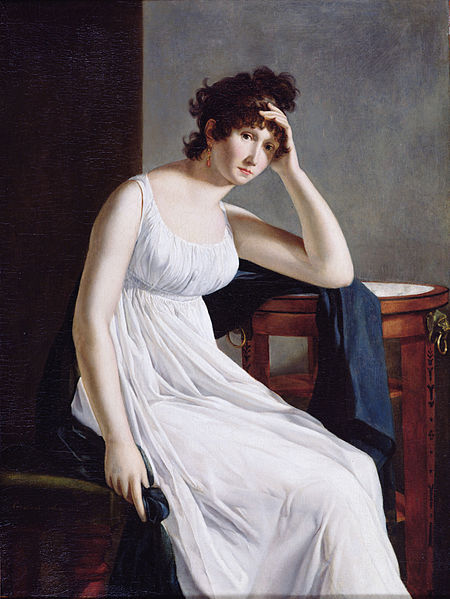In a room a woman, about thirty years of age, sits alone. The room is plain, with two bare walls, dark and grey. Its furniture is sparse, just a chair and a round table with round brass handles. The woman wears a simple white cotton dress. It has a high waistband and lacks sleeves, leaving her long arms bare. She wears no jewelry or other adornments, apart from earrings. She leans her left elbow on a dark blue cloth hanging from the table, and her left hand props up her head, so that her left eye is in shadow. Her eyes gaze steadily out at the viewer.
There’s something not quite accurate about this description. The woman is not alone. There’s another person in the room – the painter. The painter and the subject are the same person – because this a self-portrait, made in Paris around 1805 by Constance Mayer.
Constance Mayer has born in Chauny, Picardy in 1775. Her father was a civil servant, who encouraged her artistic gifts. Women painters were not rare in France from the 1780s, especially after the Revolution, and many were visible in their own right, rather than hidden as assistants in the studios of male painters. But most, unlike Constance, were the daughters of established artists. In 1801 she painted a double portrait of her father and herself. He points to a bust of Raphael as an ideal model for any beginner artist to emulate, but the picture is dominated by the statuesque and determined figure of Constance herself. As he directs her to the past, her fingers are already exploring the portfolio beside her – a metaphor for her own, yet to be born art.
Mayer’s first teachers were Joseph-Benoit Suvée and Jean-Baptiste Greuze. From 1802 she worked with the painter Pierre-Paul Prud’hon, and shared his life, rearing his children after his wife suffered a mental illness. They worked on the same projects, and historians have had difficulty identifying who did what.
This is even true of another, informal portrait of Constance, in which she turns her head and smiles. When Prud’hon’s wife died in 1821 he refused to commit to Constance by marrying her. Horrified, she seized his razor and cut her own throat. It’s impossible today to reconstruct the events and mental processes that led up up to this horrific end, though some have tried.
Her violent death is how Constance Mayer is often recalled, if she’s recalled at all. But it’s better, I think, to remember her by her self-portrait. It makes a stark contrast with the self-portraits of earlier women artists in France, like Adélaïde Labille-Guiard and Élisabeth Vigée Le Brun. These women wear the elaborate and colourful clothing – costume would be a better word – of the old régime. They also wear bright, confident smiles. Constance’s dress, on the other hand, reflects the new republican appetite, pioneered by the neo-classicist Jacques-Louis David, for a democratic simplicity and the purity of whiteness.
But it isn’t just a change of taste that marks Mayer’s painting out as a work of clarity and freshness. Unlike the other two painters she doesn’t aim to impress with her status or appearance. She’s not trying to be winning through her posture or manner or look. There are no badges or tokens in the picture of her profession, like an easel or palette, or of her accomplishments, like a book or a musical instrument. She is, quite simply, being herself: relaxed but alert, self-assured but undemonstrative, direct but reserved. She looks back calmly at herself the painter, one eye brightly lit, the other veiled.






Leave a Reply